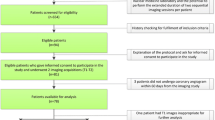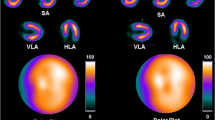Abstract
Background
Our segmentation algorithm for single-photon emission computed tomographic perfusion studies was, tested in 244 patients treated by thrombolysis within 5 hours after onset of symptoms. This algorithm, uses radial slices to approximate true three-dimensional gradients, determines the apex and basal plane, and creates a perfusion and volume polar map.
Methods and Results
Perfusion defect size was compared with enzymatic infarct size and global and regional function. All patients underwent rest planar and tomographic 99mTc-labeled sestamibi scanning, contrast coronary angiography, and ventriculography 10 to 14 days after the start of treatment. Manual correction had to be performed in only 10% of the cases and presented no problems. The correlation coefficients (r) between planar and relative tomographic perfusion defects versus enzymatic infarct size were 0.71 and 0.73. A negative correlation was found with left ventricular ejection fraction: r=-0.65 and r=-0.60. A comparable correlation was also found between regional wall motion and perfusion defect size. Most correlations were higher in the case of anterior infarction. An excellent correlation was found between planar and tomographic defect size (r=0.83).
Conclusions
In most cases, our segmentation algorithm delineates myocardial edges and basal plane automatically. A good correlation was found between perfusion defect size, enzymatic infarct size, and global and regional ventricular function.
Similar content being viewed by others
References
Geltman E, Abenschein D, Devries S. Assessment of coronary thrombolysis. Cardiol Clin 1987;5:55–66.
Sinusas AJ, Beller GA, Smith WH, Vinson EL, Brookeman V, Watson DD. Quantitative planar imaging with technetium-99m-methoxyisobutyl isonitrile: comparison of uptake patterns with thallium-201. J Nucl Med 1989;30:1456–63.
Keyes J, Brady T, Leonard P, et al. Calculation of viable and infarcted myocardial mass from thallium-201 tomograms. J Nucl Med 1981;22:339–43
Holman B, Moore S, Shulkin P, Carl-Martin K, English R, Hill T. Quantitation of perfused myocardial mass using Tl-201 and emission computed tomography. Invest Radiol 1983;18:322–6.
Caldwell J, Williams D, Harp G, Stratton J, Richie J. Quantitation of size of relative myocardial perfusion defect by single-photon emission computed tomography. Circulation 1984;70:1048–55.
Weiss R, Buda, A, Pasyk S, O’Neill W, Keyes J, Pitt B. Noninvasive quantification of jeopardized myocardial mass in dogs using 2-dimensional echocardiography and thallium-201 tomography. Am J Cardiol 1983;52:1340–4.
Burow R, Pond M, Schafer A, Becker L. Circumferential profiles: “a new method for computer analysis of thallium-201 myocardial perfusion images”. J Nucl Med 1979;20:771–7.
Garcia E, Maddahi J, Berman D, Waxman A. Space/time quantitation of thallium-201 myocardial scintigraphy. J Nucl Med 1981;22:309–17.
Garcia E, Van Train K, Maddahi J, et al. Quantification of rotational thallium-201 myocardial tomography. J Nucl Med 1985;26:17–26.
Garcia E, DePuey E, DePasquale E. Quantitative planar and tomographic thallium-201 myocardial perfusion imaging. Cardiovasc Intervent Radiol 1987;10:374–83.
Ritchie J, Williams D, Harp G, Stratton J, Caldwell J. Transaxial tomography with thallium-201 for detecting remote myocardial infarction. Am J Cardiol 1982;50:1236–41.
Wolfe C, Jansen D, Corbett J, et al. Determination of left ventricular mass using single-photon emission computed tomography. Am J Cardiol 1985;56:761–4.
Kaul S, Chesler D, Boucher C, Okada R. Quantitative aspects of myocardial perfusion imaging. Semin Nucl Med 1987;17:131–44.
Wackers FJT, Bermans DS, Maddahi J, et al. Technetium-99m hexakis 2-methoxyisobutylisonitrile: a new radiopharmaceutical for myocardial perfusion imaging: human biodistribution, dosimetry, safety, and preliminary comparison to thallium-201 myocardial imaging (phase I and II studies). J Nucl Med 1989;30:301–11.
Nuyts J, Mortelmans L, Suetens P, Oosterlinck A, De Roo M. Model-based quantification of myocardial perfusion images from SPECT. J Nucl Med 1989;30:1992–2001.
Nuyts J, Suetens P, Oosterlinck A, De Roo M, Mortelmans L. Delineation of ECT images using blobal constraints and dynamic programming. IEEE Trans Med Imaging 1991;10:489–98.
Van de Werf F, Janssens L, Brzostek T, et al. Short-term effects of early intravenous treatment with a β-blocker or a specific bradycardiac agent in patients with acute myocardial infarction receiving thrombolytic therapy. J Am Coll Cardiol 1993;22:407–16.
Wackers F, Gibbons R, Verani M, et al. Serial quantitative planar technetium-99m isonitrile imaging in acute myocardial infarction: efficacy for noninvasive assessment of thrombolytic therapy. J Am Coll Cardiol 1989;14:861–73.
Koster K, Wackers JFT, Mattera JA, Etterman RC. Quantitative analysis of planar technetium-99m-sestamibi myocardial perfusion images using modified background subtraction. J Nucl Med 1990;31:1400–8.
Metz CE, Beck RN. Quantitative effects of stationary linear image processing on noise and resolution of structure in radionuclide images. J Nucl Med 1974;15:164–70.
Diamond G, Forrester J. Analysis of probability as an aid in the clinical diagnosis of coronary artery disease. N Engl J Med 1979;300:1350–8.
Jang IK, Vanhaecke J, De Geest H, Verstraete M, Collen D, Van de Werf F. Coronary thrombolysis with recombinant tissue-type plasminogen activator: patency rate and regional wall motion after 3 months. J Am Coll Cardiol 1986;8:1455–60.
Sandler H, Dodge HT. The use of single plane angiograms for the calculations of the left ventricular volume in man. Am Heart J 1968;78:325–34.
Sheehan FH, Mathey DG, Schofer J, Krebber HJ, Dodge HT. Effect of interventions in salvaging left ventricular function in acute myocardial infarction: a study of intracoronary streptokinase. Am J Cardiol 1983;52:431–8.
Sheehan FH, Bolson EL, Dodge HT, Matehy DG, Schofer J, Woo HW. Advantages and applications of the centerline method for characterizing regional ventricular function. Circulation 1986;74:293–305.
The TIMI Study Group. The Thrombolysis in Myocardial Infarction (TIM) Trial., N Engl J Med 1985;312:932–6.
Van de Laarse A, Hermens WT, Hollaar L, et al. Assessment of myocardial damage in patients with acute myocardial infarction by serial measurement of serum α-hydroxybutyrate dehydrogenase levels. Am Heart J 1984;107:248–60.
Gardner MJ, Gardner SB, Winter PD. Confidence interval analysis (CIA). Br Med J 1989;299:690.
Fisher LD, van Belle G. Biostatistics. New York: John Wiley & Sons, 1993:379–81.
Berman D, Kiat H, Van Train K, Garcia F, Friedman J, Maddahi J. Technetium-99m sestamibi in the assessment of chronic artery disease. Semin Nucl Med 1991;21:190–212.
Garcia EV, Cook CD, Van Train KF, et al. Technical aspects of myocardial SPECT imaging with technetium-99m sestamibi. Am J Cardiol 1990;66:23E-31E.
Mortelman LA, Nuyts J, Vanhaecke J, De Roo M, Van de Werf F. Experimental validation of a new quantitative method for the analysis of cardiac perfusion tomography (SPECT). Int J Card Imaging 1993;9:201–12.
Schiepers C, Nuyts J, Mortelmans L, De Roo M. Determination of cardiac volumes in PET and SPECT by delineation of myocardium. J Nucl Med 1992;933 (abstr): 933.
Kahn JK, McGhie I, Faber TL, et al. Assessment of myocardial viability with technetium-99m-20methoxy isobutyl isonitrile (MIBI) and gated tomography in patients with coronary artery disease. J Am Coll Cardiol 1989;13:A31 (abstract).
Mortelmans L, Nuyts J, Scheys I, et al. A new quantitative method for the analysis of cardiac perfusion tomography (SPECT): validation in patients treated with thrombolytic therapy. Eur J Nucl Med 1993;12:1193–200.
Mortelmans L, Nuyts J, Schiepers C, Vleugels S, De Roo M, Van de Werf F. Evaluation of myocardial viability by comparison of FDG and MIBI polar maps. Eur J Nucl Med 1991;18:521 (abstract).
Gibbons RJ, Verani MS, Behrenbeck T, et al. Feasibility of tomographic technetium-99m-hexabis-2-methoxy-2-methylpropyl-isonitrile imaging for the assessment of myocardial area at risk and the effect of acute treatment in myocardial infarction. Circulation 1989;80:1277–86.
Christian TF, Behrenbeck T, Pellikka PA, et al. Mismatch of left ventricular function and perfusion with Tc-99m-isonitrile following reperfusion therapy for acute myocardial infarctions: identification of myocardial stunning and hyperkinesis. J Am Coll Cardiol 1990;16:1632–8.
Gibbons RJ. Technetium-99m sestamibi in the assessment of acute myocardial infarction. Semin Nucl Med 1991;21:213–22.
Morrison J, Coromilas J, Munsey D, et al. Correlation of radionuclide estimates of myocardial infarction size and release of creatinine kinase-MB in man. Circulation 1980;62:277–87.
Faraggi M, Assayag P, Messian O, et al. Early isonitrile SPECT in acute myocardial infarction: feasibility and results before and after fibrinolysis. Nucl Med Commun 1989;10:539–49.
Author information
Authors and Affiliations
Additional information
All editorial decisions for this article, including selection of reviewers and the final decision, were made by a guest editor. This procedure applies to all manuscripts with authors from Yale University, School of Medicine.
Rights and permissions
About this article
Cite this article
Mortelmans, L.A., Wackers, F.J., Nuyts, J.L. et al. Tomographic and planar quantitation of perfusion defects on technetium 99m-labeled sestamibi scans: Evaluation in patients treated with thrombolytic therapy for acute myocardial infarction. J Nucl Cardiol 2, 133–143 (1995). https://doi.org/10.1016/S1071-3581(95)80024-7
Received:
Accepted:
Issue Date:
DOI: https://doi.org/10.1016/S1071-3581(95)80024-7




